 |

Cost
& Management Accounting
(MGT-402)
VU
Absorption
Costing
Marginal
Costing
100
units
100
units
Direct
Material
8,000
8,000
Rs.
80 per unit
5,000
5,000
Direct
Labor
Rs.
50 per unit
3,000
3,000
Factory
Overhead
2,000
Variable
FOH
Fixed
FOH
18,000
16,000
Product
Cost
2,000
Fixed
Cost
(Period
Expenses)
Cost
per Unit
Under
Absorption costing
18,000
Rs.
180 per unit
100
Under
Marginal costing
16,000
Rs.
160 per unit
100
Contribution
Margin
Contribution
margin is the difference
between sales and the
variable cost of
sales.
This
can be written as:
Contribution
margin = Sales less
variable
costs of sales
Contribution
margin is short for
"contribution to fixed costs
and profits".
The
idea is that after deducting
the variable costs from
sales, the figure remaining is
the amount
that
contributes to fixed costs,
and once fixed costs
are covered the remaining
amount is that of
profits.
Contribution
and profit
Marginal
costing values goods at variable
cost of production (or marginal cost)
and contribution
can
be shown as follows;
Marginal
costing: Profit calculation
Rs
X
Sales
(X)
Less:
variable costs
X
Contribution
margin
(X)
Less:
fixed costs
X
Profit
Profit
is contribution less
fixed
costs. In absorption costing this is
effectively calculated in one
stage
as the cost of sales already
includes fixed costs
169

Cost
& Management Accounting
(MGT-402)
VU
Absorption
costing: profit calculation
Rs
Sales
X
Less:
absorption cost
(X)
Profit
X
Profit
statements under absorption
and marginal costing
To
produce financial statements in
accordance with IFRS 2,
absorption costing must be used,
but
either
marginal or absorption costing can be
useful for internal
management reporting the
choice
made
will affect:
·
The way
in
which profit information is
presented
·
The level of reported profit if
sales do not exactly equal
production (i.e. stock is increasing
or
decreasing).
PRACTICE
QUESTION
This
example continues with the
Company from the above
practice question.
Show
profit statements for the
month if sales are 4,800
units and production is
5,000 units under
(a)
Total absorption costing
(b)
Marginal costing.
Solution
(a)
Profit statement under absorption
casting
Rs.
Rs
Sales
(4,800 @ Rs10)
48,000
Less:
Cost
of sates
Opening
stock
Production
(5,000
@ Rs. 8)
40,000
Less:
Closing stock
(200 @ Rs. 8)
(1,600)
(38.400)
Operating
profit
9,600
(b)
Profit statement under marginal
costing
Sales
(4.800 @ Rs10)
48,000
Less:
Cost
of sates
Opening
stock
Production
(5,000 @ Rs6)
30,000
Less:
Closing stock (200 @ Rs6)
(1,200)
(28,800)
Contribution
19,200
Less:
Fixed overheads
10,000
Operating
profit
9,200
170

Cost
& Management Accounting
(MGT-402)
VU
PRACTICE
QUESTION
Absorption
Costing
Marginal
100
units
Costing
100
units
Direct
Material
8,000
8,000
Rs.
80 per unit
Direct
Labor
5,000
5,000
Rs.
50 per unit
Factory
Overhead
Variable
FOH
3,000
3,000
Fixed
FOH
2,000
Product
Cost
18,000
16,000
Fixed
Cost
(Period
Expenses)
2,000
Cost
per Unit
Under
Absorption costing
18,000
Rs.
180 per unit
100
Under
Marginal costing
16,000
Rs.
160 per unit
100
Prepare
income statements under absorption
and marginal costing systems assuming
the following
facts:
a)
All
produced units Sold
b)
No.
of units sold
80
No.
of units in closing stock
20
No.
of units produced
100
c)
No.
of units sold
110
No.
of units in opening stock
10
No.
of units produced
100
171
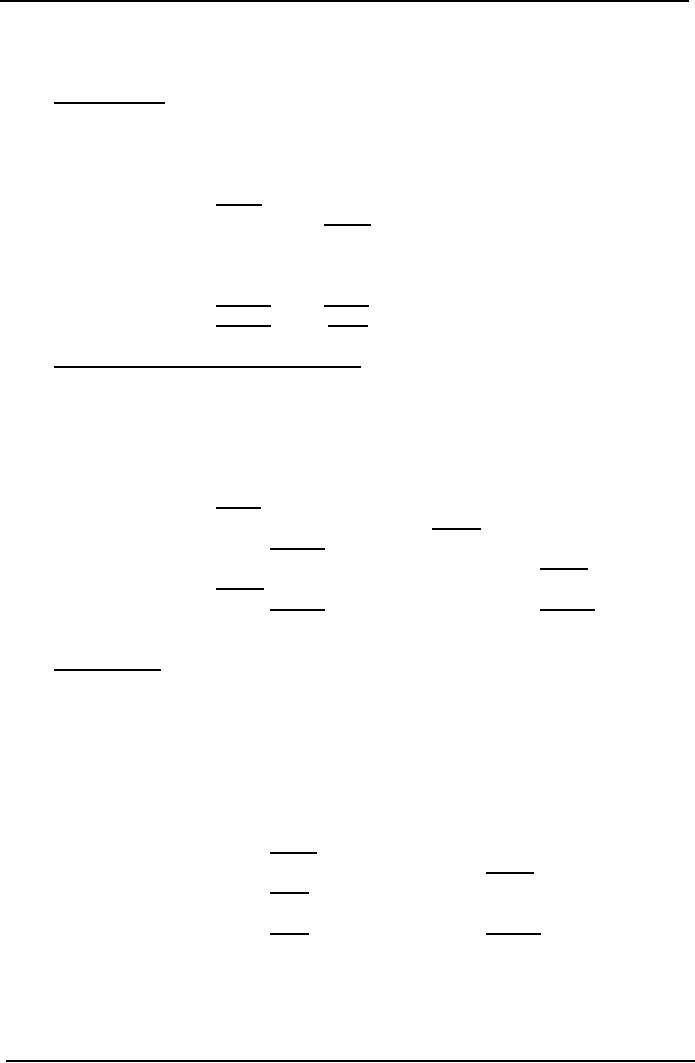
Cost
& Management Accounting
(MGT-402)
VU
Selling
price Rs. 240 per
unit
Solution
a)
All
Units Sold
Absorption
Marginal
costing
costing
Sales
(110 x 240)
24,000
24,000
Less
Product cost
100
x 180
18,000
100
x 160
16,000
Gross
profit
6,000
Contribution
margin
8,000
Less
Fixed cost
0
(2000)
Profit
6,000
6,000
b)
80
units sold & 20 units in closing
stock
Absorption
costing
Marginal
costing
Sales
80 x 240
19,200
19,200
Production
cost
100
x 180 =
18,000
100
x 160 =
16,000
Less
closing stock
20
x 180 =
(3600)
20
x 160 =
(3,200)
14,600
12,800
Less
Fixed cost
2,000
Contribution
Margin
4,600
Profit
4,600
4,400
c)
110
units sold
Absorption
costing
Marginal
costing
Sales
110 x 240
26,400
26,400
Opening
stock
10
x 180 =
1,800
10
x 160 =
1,600
Production
cost
100
x 180 =
18,000
100
x 160 =
16,000
19,800
17,600
Less
Fixed cost
2,000
Contribution
Margin
6,600
Profit
6,600
6,800
Reconciliation
of the difference in profit
The
difference in profit is due to there
being a movement in stock levels - an
increase from 0 to
200
units over the
month.
172
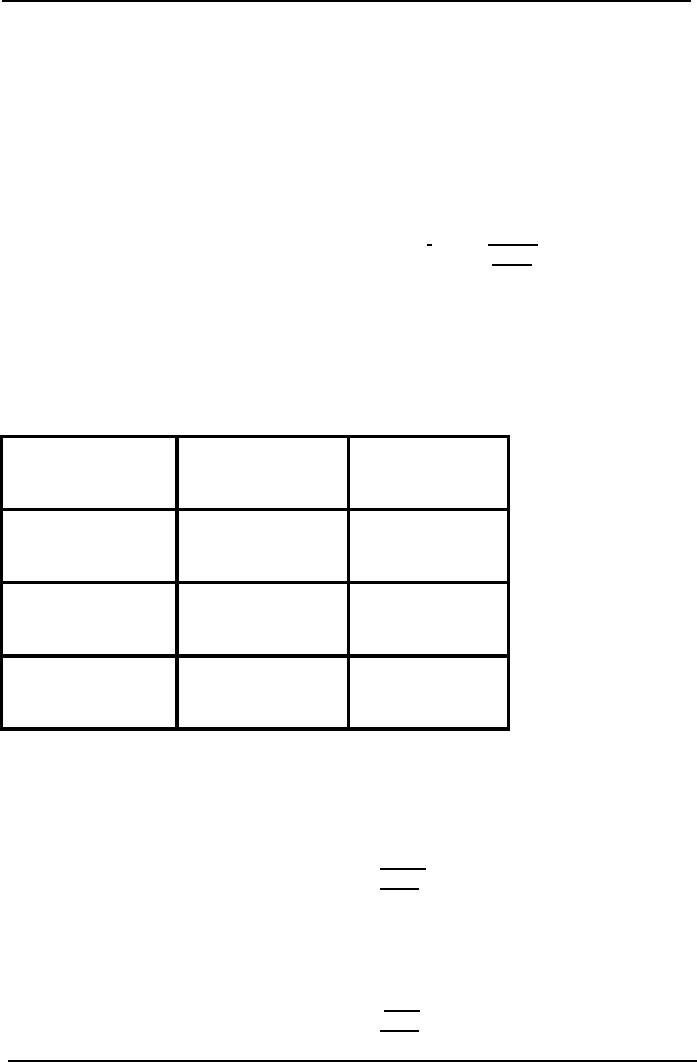
Cost
& Management Accounting
(MGT-402)
VU
Under
absorption costing closing stock has been
valued at Rs 1,600 (i.e. Rs 8 per
unit which
includes
Rs 2 of absorbed fixed overheads).
Under marginal costing the increase in
stock is valued
at
Rs 1,200 (i.e. at Rs 6 per
unit) and all fixed
overheads are charged to the
profit and loss
account.
Only
if stock is rising or falling will
absorption costing give a different
profit figure from
marginal
costing.
If sales equal production,
the fixed overheads absorbed
into cost of sales under
absorption
costing
will be the same as the
period costs charged under marginal
costing and thus the
profit
figure
will be the same.
The
two profit figures can
therefore be reconciled as
follows:
Rs
Absorption
costing profit
9,600
Less:
fixed costs included in the
increase in stock (200 x
Rs2)
(400)
Marginal
costing profit
9,200
If
stock levels are rising from
opening to closing balance
Absorption
Costing profit > Margin Costing
profit
If
stock levels are falling
from opening to closing
balance
Absorption
Costing profit < Margin Costing
profit
(Fixed
costs carried forward are
charged in this period, under
absorption costing)
If
stock levels are the
same
Absorption
Costing profit = Margin Costing
profit
Absorption
Costing Marginal
Costing
Produced
units = Units
Same
Profit
Same
Profit
sold
Produced
units > Units
More
Profit
Less
Profit
sold
Produced
units < Units
Less
Profit
More
Profit
sold
Reconciliation
of the above practice question
b)
80
units sold & 20 units in closing
stock
Rs
Absorption
Profit
4,800
Less
Closing Stock @ Fixed FOH Rate
20
x
20
(400)
Marginal
Costing Profit
4,400
c)
110
units sold with an opening stock of 10
units
Absorption
Profit
6,600
Add
Opening Stock @ Fixed FOH
Rate
10
x
20
200
Marginal
Costing Profit
6,800
173

Cost
& Management Accounting
(MGT-402)
VU
Reconciliation
formula to learn
Rs
Profit
as per absorption costing
system
xxx
Add
Opening stock @ fixed FOH rate at opening
date
xxx
Less
Closing stock @ fixed FOH rate at closing
date
xxx
Profit
as per marginal costing system
xxx
Advantages
of marginal costing
(Relative
to the absorption
costing)
Preparation
of routine operating statements using
absorption costing is considered less
informative
for
the following
reasons:
1.
Profit per unit is a
misleading figure: in the
example above the operating
margin of Rs2 per
unit
arises because fixed
overhead per unit is based
on output of 5,000 units. If
another basis
were
used margin per unit
would differ even though
fixed overhead was the
same amount in
total
2.
Build-up or run-down of stocks of
finished goods can distort
comparison of period operating
statements
and obscure the effect of
increasing or decreasing
sales.
3.
Comparison between products can be
misleading because of the
effect of arbitrary
apportionment
of fixed costs. Where two or
more products are
manufactured in a factory
and
share
all production facilities, the
fixed overhead can only be
apportioned on an arbitrary
basis.
4.
Marginal costing emphasizes variable
costs per unit and
fixed costs in total whereas
absorption
costing
accounts for all production
costs to calculate unit
cost. Marginal costing
therefore
reflects
the behavior of costs in
relation to activity. Since
most decision-making problems
involve
changes to activity, marginal costing is
more appropriate for short-run
decision-making
than
absorption costing.
PRACTICE
QUESTION
This
practice question illustrates the
misleading effect on profit
which absorption costing can
have.
A
company sells a product for
Rs10. and incurs Rs4 of
variable costs in its manufacture.
The fixed
costs
are Rs900 per year
and are absorbed on the
basis of the normal
production volume of
250
units
per year. The results for
the last four years,
when no expenditure variances
arose- were as
follows:
2nd year
3rd year
4th
year Total
Item
1st
year
units
units
units
units
Opening
stock
200
300
300
Production
300
250
200
200
950
300
450
500
500
950
Closing
stock
200
300
300
200
200
Sales
100
150
200
300
750
Rs
Rs
Rs
Rs
Rs
Sales
value
1,000
1,500
2,000
3,000
7,500
Prepare
a profit statement under absorption
and marginal costing.
174
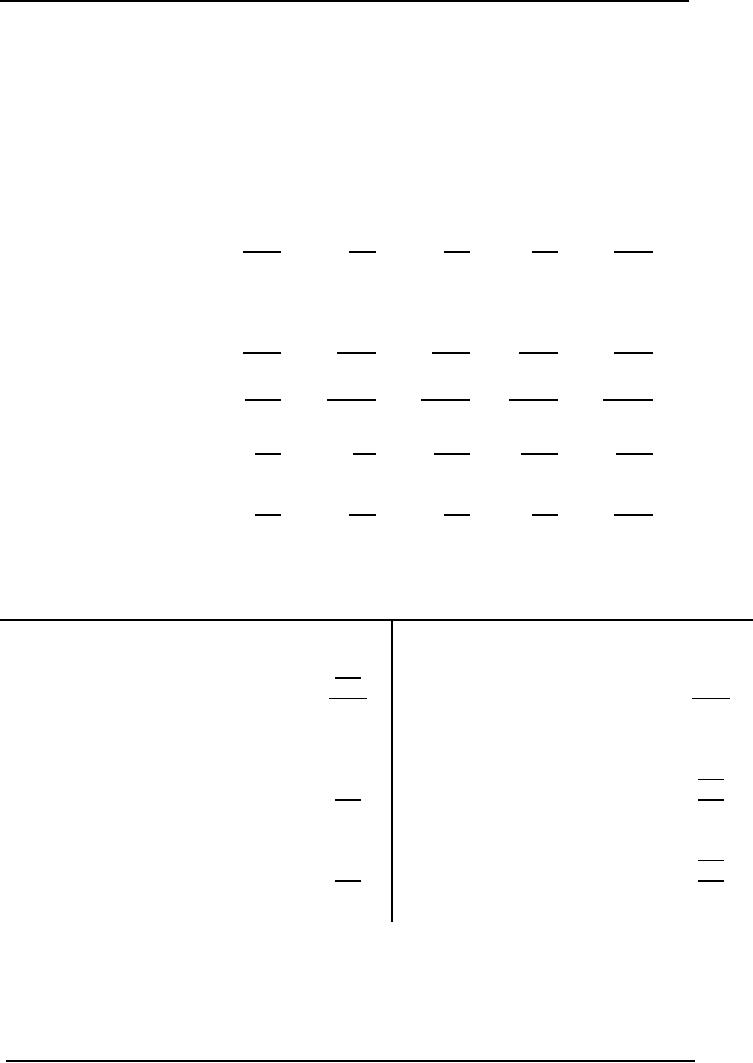
Cost
& Management Accounting
(MGT-402)
VU
Solution
The
profit statement under absorption costing
would be as follows:
1st year
2nd year
3rd year
4th year
Items
Total
Rs.
Rs.
Rs.
Rs.
Rs.
Opening
stock @ Rs7.60
1,520
2,280
2,280
Variable
costs
of
1,200
1,000
800
800
3,800
production
@ Rs4
Fixed
costs ® 900/250
1,080
900
720
720
3,420
=Rs3.60
2,280
3,420
3,800
3,800
7,220
Closing
stock @Rs7.60
1,520
2,280
2,280
1,520
1,520
Cost
of sales
(760)
(1,140)
(1,520)
(2,280)
(5,700)
(Under)/over
absorption
180
Nil
(180)
(180)
(180)
(w)
Net
Profit
420
360
300
540
1,620
Working:
Calculation
of over / under
absorption
Fixed
cost control account
Incurred
Year 1
900
Absorbed
1,080
300
x Rs. 3.60
Over
absorption
180
1,080
1,080
Year
2
900
250
x Rs. 3.60
Year
3
900
200
x Rs. 3.60
720
Under
absorption
180
900
900
Year
4
900
200
x 3.60
720
Under
absorption
180
900
900
175
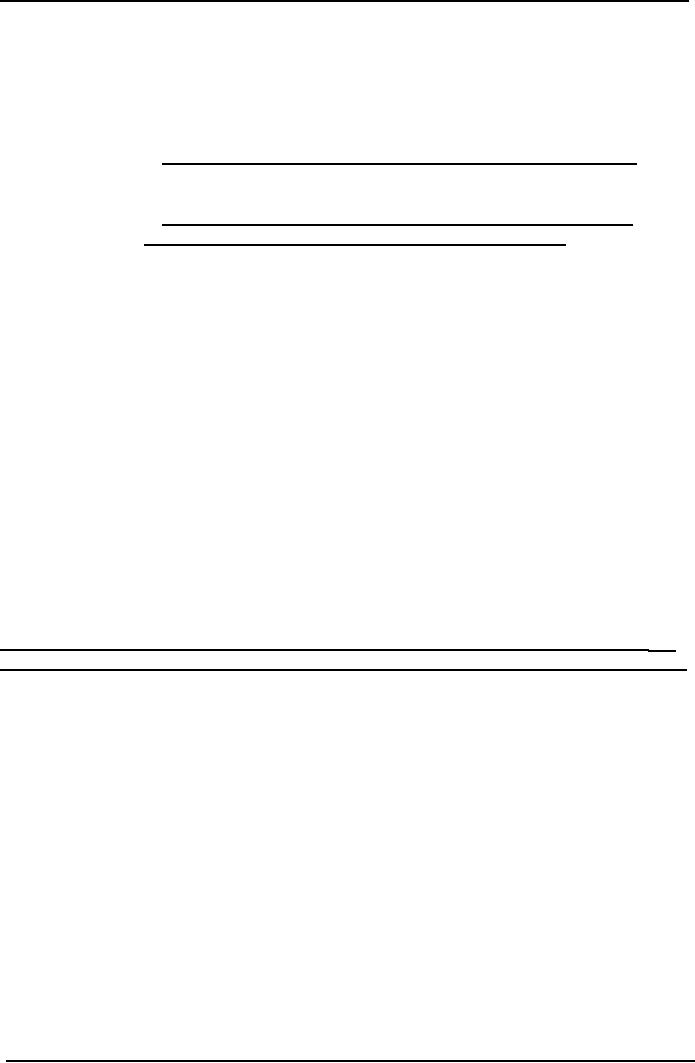
Cost
& Management Accounting
(MGT-402)
VU
If
marginal costing had been used
instead of absorption, the results
would have
been
shown as
follows:
Item
1st
year
2nd
year
3rd
year
4th
year
Total
Rs
Rs
Rs
Rs
Rs
Sales
1,000
1,500
2,000
3,000
7,500
Variable
cost of sales
(@
Rs4)
400
600
800
1,200
3,000
Contribution
margin 600
900
1,200
1,800
4,500
Fixed
costs
900
900
900
900
3,600
Net
profit/ (loss)
(300)
-
300
900
900
The
marginal presentation indicates clearly that
the business must sell at
least 150 units per
year to
break
even, i.e. Rs900 + (10 -
4), whereas it appeared, using
absorption costing, that even at
100
units
it was making a healthy
profit.
The
total profit for the
four years is less under
the marginal principle because
the closing stocks at
the
end of the fourth year
are valued at Rs800 (Rs4 x
200) instead of Rs 1,520,
i.e. Rs720 of the
fixed
costs are being carried
forward under the absorption
principle.
The
profit figures shown may be reconciled as
follows:
Year
1
Year
2
Yea
3
Yea
r4
Total
Rs
Rs
Rs
Rs
Rs
Profit
/ (loss)
Under
marginal costing
(300)
Nil
300
900
900
Add:
Fixed overheads
Absorbed
in stock increase
200
x Rs3.60 =
720
100
x Rs3.60=
360
200
x Rs3.60=
720
Less:
Fixed overheads
Absorbed
in stock decrease
100
x 3.60=
(360)
Profit
per absorption
420
360
300
540
1,620
Problem
Questions
Q.1.
A
factory manufactures three components X,
Y and Z and the budgeted
production for the
year
is 1,000 units1,500 units and
2,000 units respectively. Fixed overhead
amounts to Rs6.750
and
has
been apportioned on the
basis of budgeted units: Rs
1,500 to X, Rs 2,250 to Y and Rs
3,000 to
Z.
Sales and variable costs
are as follows:
X
Y
Z
Selling
price Rs.
4
6
5
Variable
cost Rs.
1
4
4
Q.
2. A
company that manufactures one product
has calculated its cost on a
quarterly production
budget
of 10.000 units. The selling
price was Rs 5 per unit.
Sales in the four successive
quarters of
the
last year were as
follows:
Quarter
1
10,000
units
Quarter
2
9,000
units
Quarter
3
7,000
units
176

Cost
& Management Accounting
(MGT-402)
VU
Quarter
4
5,500
units
The
level of stock at the beginning of the
year was 1,000 units
and the company maintained
its
stock
of finished products at the
same level at the end of
each of the four
quarters.
Based
on its quarterly production budget, the
cost per unit was as
follows:
Cost
per unit
Rs.
Prime
cost
3.50
Production
overhead
0.75
Selling
and administration
overhead
0.30
Total
4.55
Fixed
production overhead, which
has been taken into account
in calculating the above figures,
was
Rs 5,000 per quarter.
Selling and administration
overhead was treated as
fixed, and was
charged
against sales in the period in
which it was
incurred.
You
are required to present a tabular
statement to bring out the
effect on net profit of
the
declining
volume of sales over the
four quarters given, assuming in
respect of fixed
production
overhead
that the company:
(a)
Absorbs it at the budgeted rate
per unit
(b)
Does not absorb it into
the product cost, but
charges it against sales in
each quarter (i.e.
the
company
uses marginal costing).
Advantages
of Absorption Costing
(Relative
to marginal costing)
Absorption
costing is widely used and
you must understand both
principles.
The
only difference between using
absorption costing and marginal costing as
the basis of stock
valuation
is the treatment of fixed
production costs.
The
arguments used in favor of absorption
costing are as follows:
1.
Fixed costs are incurred
within the production
function, and without those
facilities
production
would not be possible. Consequently such
costs can be related to
production
and
should be included in stock
valuation.
2.
Absorption costing follows the
matching concept by carrying forward a
proportion of the
production
cost in the stock valuation to be matched
against the sales
value
3.
When the items are
sold.
4.
It is necessary to include fixed
overhead in stock values for
financial statements
routine
cost
accounting using absorption costing
produces stock values which
include a share of
fixed
overhead.
5.
Overhead allotment is the
only practicable way of obtaining
job costs for estimating
prices
and
profit analysis.
6.
Analysis of under-/over-absorbed overhead is
useful to identify inefficient
utilization of
production
resources.
Arguments
against absorption
costing
The
fixed costs do not change as
a result of a change in the
level of activity. Therefore such
costs
cannot
be related to production and
should not be included in
the stock valuation.
The
inclusion of fixed costs in
the stock valuation conflicts
with the prudence concept,
therefore
the
fixed costs should be
written off in the period in
which they are
incurred.
177
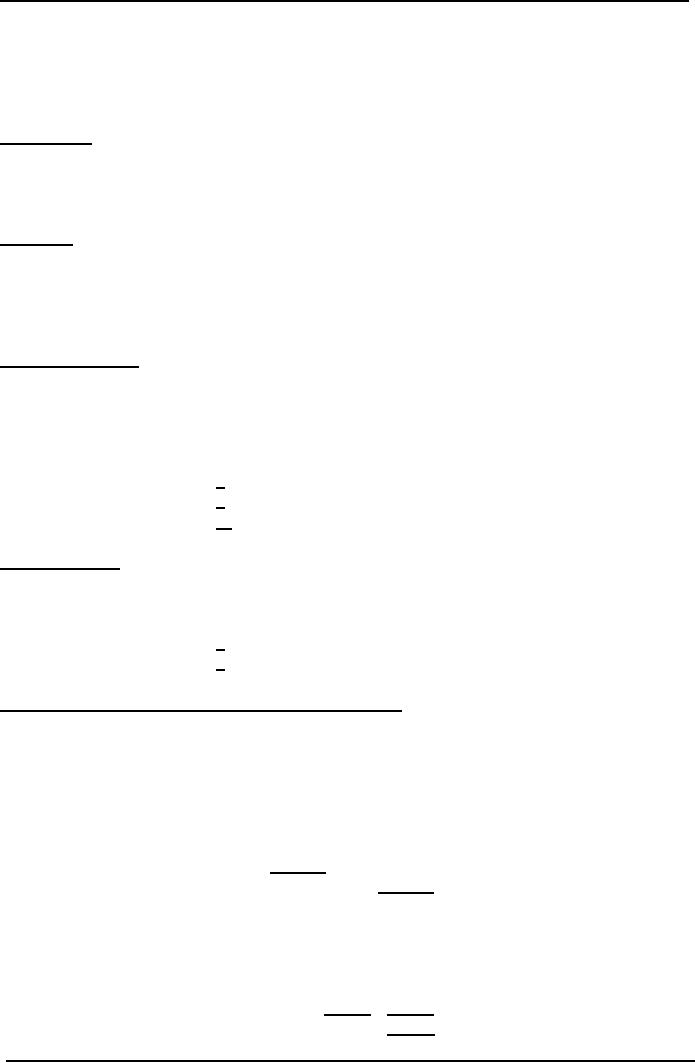
Cost
& Management Accounting
(MGT-402)
VU
PRACTICE
QUESTION
Following
information relates to a manufacturing
company
Selling
price
Rs.
20 per unit
Units
produced
30,000
Units
sold
20,000
Variable
cost
Direct
material
Rs.
5 per unit
Direct
labor
Rs.
3 per unit
F.O.H
Rs.
1 per unit
Selling
& administrative expenses
Rs.
2 per unit
Fixed
cost
F.O.H
Rs
120,000
Selling
& administrative expenses
Rs.
15,000
Solution
Working
for cost per unit
under
Absorption
Costing
Fixed
FOH Rate
120,000/30,000
=
4
Variable
FOH Rate
Direct
Material
5
Direct
Labor
3
FOH
1
9
13
Marginal
Costing
Variable
FOH Rate
Direct
Material
5
Direct
Labor
3
FOH
1
9
Income
Statement under Absorption Costing
System
Rupees
Sales
(20,000 x 20)
400,000
Less
Cost of goods sold
Opening
stock
0
Add
Production cost
(13
x 30,000)
390,000
Less
Closing stock
(13
x 10,000)
130,000
260,000
Gross
Profit
140,000
Less
Operating expenses
Selling
& Administrative expenses
Variable
expenses
(20,000
x 2) =
40,000
Fixed
expenses
15,000
55,000
Net
profit
85,000
178
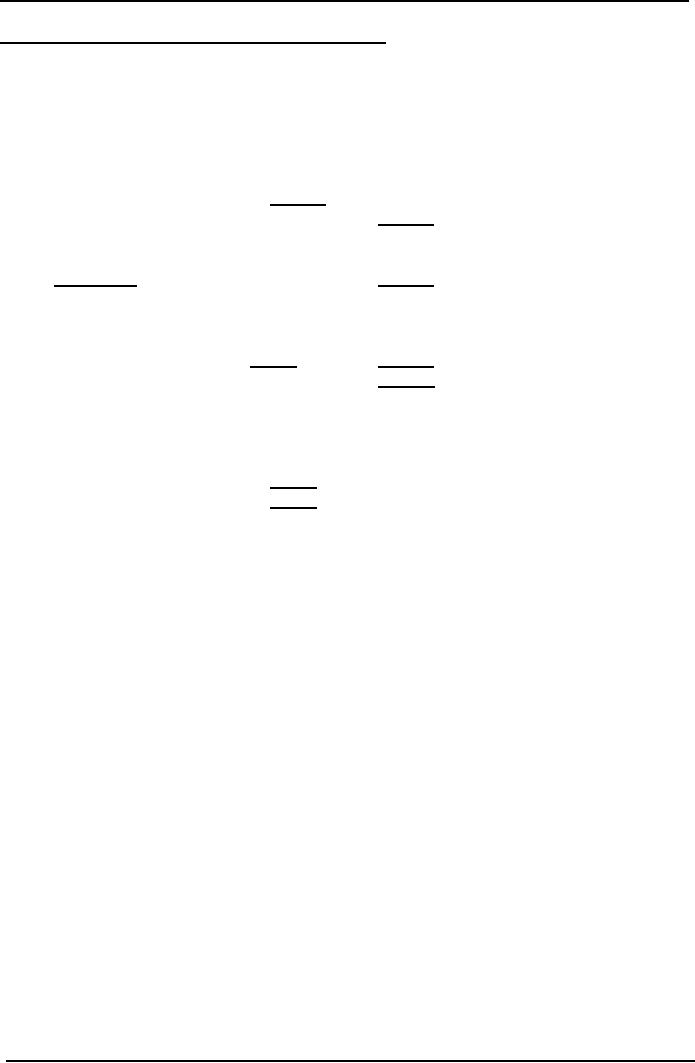
Cost
& Management Accounting
(MGT-402)
VU
Income
Statement under Marginal Costing
System
Rupees
Sales
400,000
Less
Variable cost of goods sold
Opening
stock
0
Add
Variable production cost
(9
x 30,000)
270,000
Less
Closing stock
(9
x 10,000)
90,000
180,000
Gross
contribution margin
220,000
Less
Variable Selling & Admin
Expenses
(2
x 20,000)
40,000
Contribution
margin
180,000
Less
Fixed expenses
Production
120,000
Selling
& Admin Expenses
15,000
135,000
Net
Profit
45,000
Reconciliation
Profit
as absorption costing
85,000
Less
Closing stock (10,000 x 4)
40,000
Profit
as per Marginal costing
45,000
Multiple
Choice Questions
Q.1.
When
comparing the profits reported using marginal costing
with those reported using
absorption
costing in a period when closing stock was
1,400 units, opening stock was
2,000 units,
and
the actual production was
11,200 units at a total cost
of Rs 4.50 per unit compared
to a target
cost
of Rs 5.00 per unit, which
of the following statements is
correct?
A
Absorption costing reports profits Rs
2,700 higher
B
Absorption costing reports profits Rs
2,700 lower
C
Absorption costing reports profits Rs
3,000 higher
D
There is insufficient data to
calculate the difference between
the reported profits
Q.
2. When
comparing the profits reported under
marginal and absorption costing during a
period
when
the level of stocks
increased:
A.
An
absorption costing profits will be
higher and closing stock valuations
lower than those
under
marginal
costing
B.
An
absorption costing profits will be
higher and closing stock valuations
higher than those
under
marginal costing
C.
The
marginal costing profits will be higher
and closing stock valuations lower
than those under
absorption
costing
D. The
marginal costing profits will be lower
and closing stock valuations higher
than those under
absorption
costing
Q.
3. Contribution
margin is:
A.
Sales less total
costs
B.
Sales less variable
costs
C.
Variable costs of production less
labor costs
D.
None of the above
179
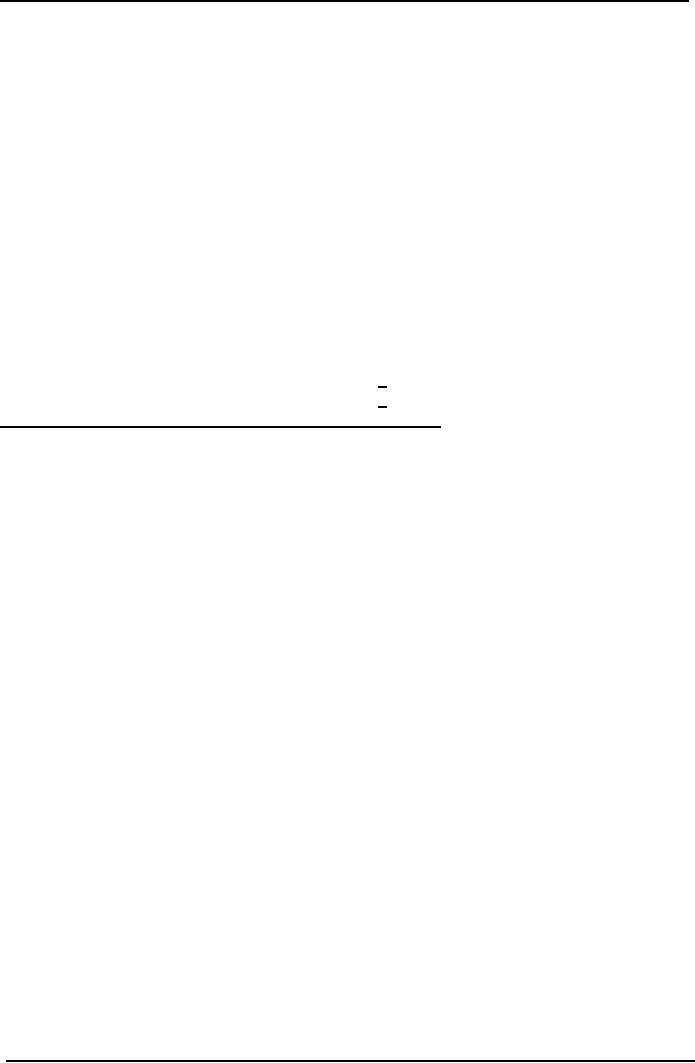
Cost
& Management Accounting
(MGT-402)
VU
Problem
Question
Rays
Company manufactures and sells electric
blankets.
The
selling price is Rs 12.
Each
blanket has the unit
cost set out
below.
Administration
costs are incurred at the
rate of Rs20 per
annum.
The
company achieved the
production and sales of blankets
set out below.
The
following information is also
relevant:
1.
The overhead costs of Rs2
and Rs3 per unit
have been calculated on the
basis of a budgeted
production
volume of 90 units.
2.
There was no
inflation.
3.
There, was no opening stock.
Unit
cost
Rs.
Direct
material
2
Direct
labor
1
Variable
production overhead
2
Fixed
production overhead
3
8
Year
1
2
3
Production
100
110
90
Sales
90
110
95
You
are required:
(a)
To prepare an operating statement for
each year using
(i)
Marginal costing and (ii)
absorption costing
(b)
To explain why the profit
figures reported under the two techniques
disagree.
180
Table of Contents:
- COST CLASSIFICATION AND COST BEHAVIOR INTRODUCTION:COST CLASSIFICATION,
- IMPORTANT TERMINOLOGIES:Cost Center, Profit Centre, Differential Cost or Incremental cost
- FINANCIAL STATEMENTS:Inventory, Direct Material Consumed, Total Factory Cost
- FINANCIAL STATEMENTS:Adjustment in the Entire Production, Adjustment in the Income Statement
- PROBLEMS IN PREPARATION OF FINANCIAL STATEMENTS:Gross Profit Margin Rate, Net Profit Ratio
- MORE ABOUT PREPARATION OF FINANCIAL STATEMENTS:Conversion Cost
- MATERIAL:Inventory, Perpetual Inventory System, Weighted Average Method (W.Avg)
- CONTROL OVER MATERIAL:Order Level, Maximum Stock Level, Danger Level
- ECONOMIC ORDERING QUANTITY:EOQ Graph, PROBLEMS
- ACCOUNTING FOR LOSSES:Spoiled output, Accounting treatment, Inventory Turnover Ratio
- LABOR:Direct Labor Cost, Mechanical Methods, MAKING PAYMENTS TO EMPLOYEES
- PAYROLL AND INCENTIVES:Systems of Wages, Premium Plans
- PIECE RATE BASE PREMIUM PLANS:Suitability of Piece Rate System, GROUP BONUS SYSTEMS
- LABOR TURNOVER AND LABOR EFFICIENCY RATIOS & FACTORY OVERHEAD COST
- ALLOCATION AND APPORTIONMENT OF FOH COST
- FACTORY OVERHEAD COST:Marketing, Research and development
- FACTORY OVERHEAD COST:Spending Variance, Capacity/Volume Variance
- JOB ORDER COSTING SYSTEM:Direct Materials, Direct Labor, Factory Overhead
- PROCESS COSTING SYSTEM:Data Collection, Cost of Completed Output
- PROCESS COSTING SYSTEM:Cost of Production Report, Quantity Schedule
- PROCESS COSTING SYSTEM:Normal Loss at the End of Process
- PROCESS COSTING SYSTEM:PRACTICE QUESTION
- PROCESS COSTING SYSTEM:Partially-processed units, Equivalent units
- PROCESS COSTING SYSTEM:Weighted average method, Cost of Production Report
- COSTING/VALUATION OF JOINT AND BY PRODUCTS:Accounting for joint products
- COSTING/VALUATION OF JOINT AND BY PRODUCTS:Problems of common costs
- MARGINAL AND ABSORPTION COSTING:Contribution Margin, Marginal cost per unit
- MARGINAL AND ABSORPTION COSTING:Contribution and profit
- COST – VOLUME – PROFIT ANALYSIS:Contribution Margin Approach & CVP Analysis
- COST – VOLUME – PROFIT ANALYSIS:Target Contribution Margin
- BREAK EVEN ANALYSIS – MARGIN OF SAFETY:Margin of Safety (MOS), Using Budget profit
- BREAKEVEN ANALYSIS – CHARTS AND GRAPHS:Usefulness of charts
- WHAT IS A BUDGET?:Budgetary control, Making a Forecast, Preparing budgets
- Production & Sales Budget:Rolling budget, Sales budget
- Production & Sales Budget:Illustration 1, Production budget
- FLEXIBLE BUDGET:Capacity and volume, Theoretical Capacity
- FLEXIBLE BUDGET:ANALYSIS OF COST BEHAVIOR, Fixed Expenses
- TYPES OF BUDGET:Format of Cash Budget,
- Complex Cash Budget & Flexible Budget:Comparing actual with original budget
- FLEXIBLE & ZERO BASE BUDGETING:Efficiency Ratio, Performance budgeting
- DECISION MAKING IN MANAGEMENT ACCOUNTING:Spare capacity costs, Sunk cost
- DECISION MAKING:Size of fund, Income statement
- DECISION MAKING:Avoidable Costs, Non-Relevant Variable Costs, Absorbed Overhead
- DECISION MAKING CHOICE OF PRODUCT (PRODUCT MIX) DECISIONS
- DECISION MAKING CHOICE OF PRODUCT (PRODUCT MIX) DECISIONS:MAKE OR BUY DECISIONS